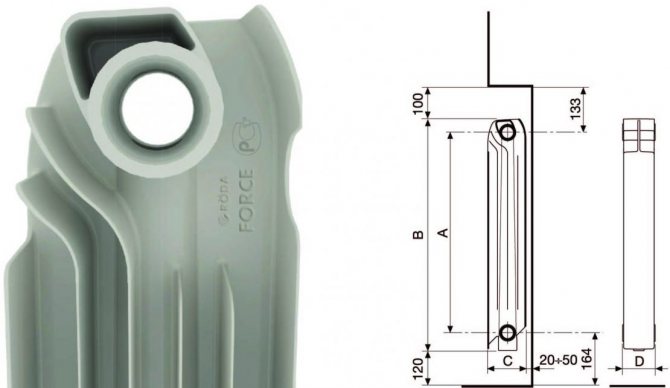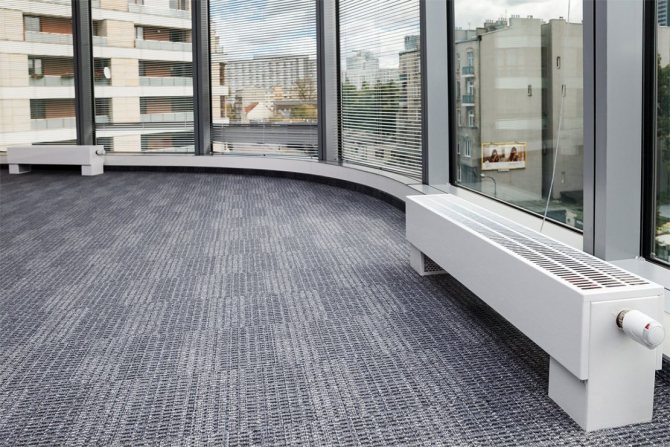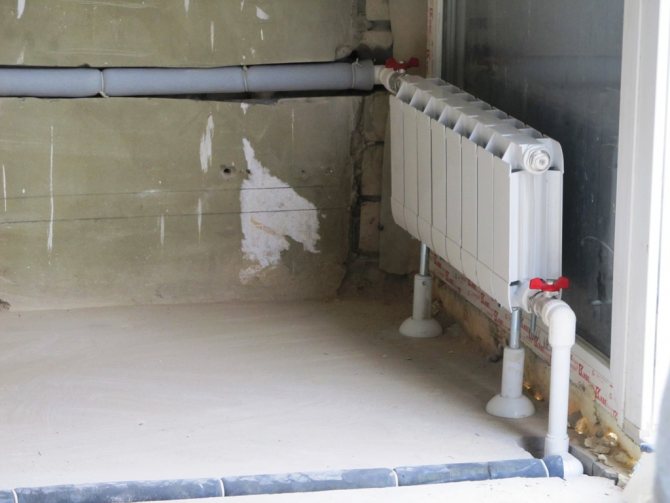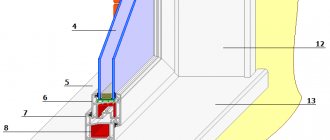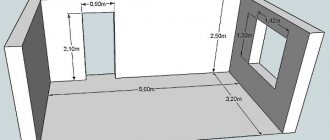Product protrusion functions
The ledge of the sill can be different. There are practically invisible structures that do not stand out behind the window opening, there are also wide, powerful window sills on which you can sit. The structure is needed to retain heat in the house, it can serve as an additional support, for example, for installing flower pots.
The window sill should be chosen carefully, it should be suitable for the window structure, otherwise it may fail. Replacing a part without removing the glass unit is extremely problematic.
Primary requirements
The distance from the floor to the window sill may differ depending on the type of window. However, the GOST provides for the permissible coefficient at which heat is best retained in the room, and the indicator is 0.55 W / ° С × m². This means that in order to achieve the desired effect, you need to use a plate that will have a low thermal conductivity.
An important role is played by the distance of the radiator to the window sill: in that case, there is a SNiP, the main provisions of which require:
- The window sill should have a slight inclination towards the interior of the room - at least 1˚.
- There must be thermal insulation between the wall and the structure.
- During installation, the height from the floor is taken into account. All window sills must be at the same level.
- The length of the window sill should not be more than 3 meters.
- The length is set relative to the window opening, with a difference of 4 mm.
- The distance required to retreat from the battery to the window sill should not be less than 8 cm.
- It is recommended to cut off excess parts at room temperature.
Distance from the floor to the radiator and battery: SNiP norms from window sills
Ensuring a comfortable temperature for people living in a private house or apartment in winter is a priority task for every owner. When organizing individual heating or heat supply in an apartment building, all elements are important, starting with what should be the distance from the floor to the heating radiator, and ending with the fluid pressure in the system. Before starting work, you should study the building codes and regulations (SNiP) concerning the organization of heat supply, and also find out at what distance experts recommend hanging the heater.
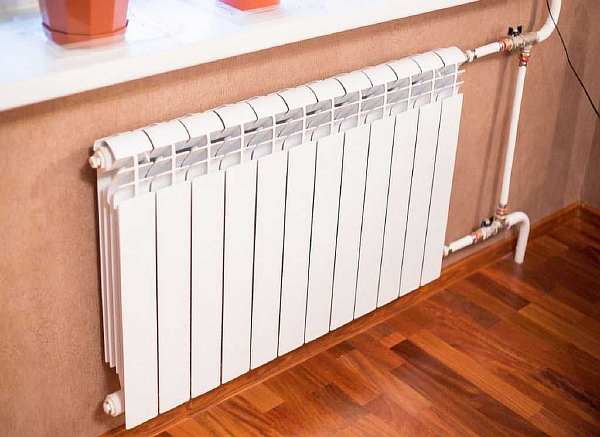
Height calculation
The distance between the radiator and the window sill must be at least 10 cm, regardless of what type of heater is used. The height of the battery itself must also be taken into account. Behind it is necessary to retreat 8 cm.The battery itself should rise 10 cm above the floor, that is, when installing the window sill from the floor according to SNIP, you will need to retreat 70-80 cm.
An important role is played by what the ledge of the windowsill will be.: it may move away from the wall significantly or be invisible. If there is no radiator under the window, it is not necessary to comply with any requirements, but if heating is present, the protrusion must be strictly regulated. The task of the window sill is to redirect heat flows. Without it, they will rise up, and proper heating of the room will not occur, since some of the heat will evaporate and be distributed on the ceiling.
A too wide window sill can also cause poor convection. It will not allow warm air to escape, as a result, condensation will begin to accumulate on the window, since the main air flows will go up, and some of them will get stuck under the window, heating the atmosphere.In this case, it is very important to calculate the distance from the window sill to the heating radiator, both in height and how much it is possible to make a protrusion. You can avoid the problem described above by using a slab that does not extend beyond the wall by more than 8 cm.
Advice: when calculating the dimensions, you need to take into account the level of the wall with decoration.
The best option is a solution in which no more than 10% of warm air will be retained in the window niche. For this, the window sill should not protrude beyond the battery by more than 6 cm, but it should not be shorter than the heater. If the design solution of the room requires the installation of non-standard wide structures, ventilation holes must be provided in them. They must be large enough for proper air circulation.
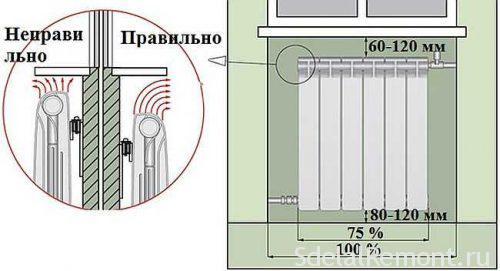

The distance between the window sill and the heating radiator will remain standard in this case. As for the thickness of the structure, it usually does not exceed 4 cm, but this figure is not a standard. A thinner slab is at risk of deformation caused by warm air currents. The thicker one has a greater mass, it is more expensive. If such structures are not provided for by the design concept, it makes no sense to install them. Detailed instructions for installing the window sill.
Do you need a gap?
Some window owners believe that the sill goes deep under the window frame, but this is not the case. The distance between the window and the sill is about 10 mm. Otherwise, the structure may deform. The fact is that under the influence of warm air, the material from which the plate is made expands. A gap is left so that the structure can take the desired shape without being damaged. Visually, this technique is invisible.
How to position the curtain?
The distance of the sill curtain also plays a role. In order for the curtains to move without clinging, there were no traces left on them, and warm air could circulate freely, the distance should be at least 5 cm.
Conclusion: it is not always possible to apply the standard distance from the floor, radiator, curtains to the window sill, but you can find a way out by observing certain requirements.
Source: sdelalremont.ru
Standards
SNiP standards are advisory in nature, but when replacing batteries in an apartment of an apartment building with a central heating system, their implementation is mandatory. This is due to the fact that when designing the house, all the conditions for its further maintenance were taken into account and, among other things, economical heat supply.
According to established standards in a brick or panel house, the following is provided:
- The distance from the floor to the radiator or radiator should be within 80–140 mm. A lower installation height will make it impossible to carry out wet cleaning under the device, will provoke the accumulation of dust undesirable for human health, a large installation will reduce the useful heating zone.
- The distance between the battery and the windowsills should be 100–120 mm. If the distance from the radiator to the window sill is reduced, then the conversion of air masses will decrease and the efficiency of the radiator will decrease.
- Installation of heating radiators from the wall by more than 30-50 mm is not recommended due to the fact that, as in the previous case, the conversion decreases, as well as provokes the accumulation of dirt with minimal possibilities for its elimination.
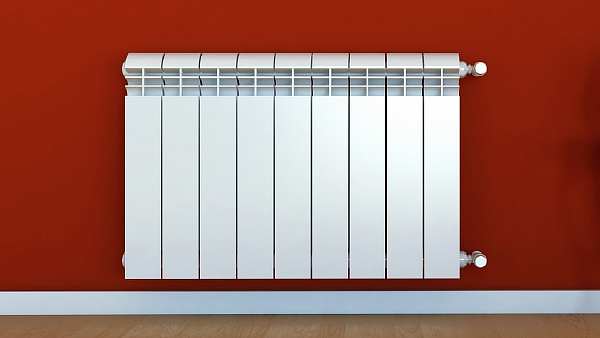

It is necessary to hang the radiator above the floor exactly in the center of the window opening. This will ensure the creation of a heat shield in the area of the glass filling of the window, while maintaining the aesthetic appearance of the room.
What is the size of the ledge of the windowsill?
Good day! Are there any criteria in determining the size of the window sill protrusion? The room has 4 windows under two window sills, there are radiators. I read in one thread that people are making a ledge in half the depth of the radiator. The size of the window sill itself (95x50).It seems that by eye it asks to make a protrusion of 3 cm, but the worker offers 5 cm.
Manufacturers of radiators and convectors, heating designers ask you not to block the air flow from above or to use more power. I made a 17 mm projection, purmo convectors.
I have convectors "Cast iron radiator" 10 sections MS-140 made in Cheboksary.
Freq wrote: It seems to be asking by eye to make a protrusion of 3 cm, but the worker offers 5 cm.
People do whoever they want. Sometimes, according to the design project, there is a table top from the window. The radiator is not visible at all. In short, "in life" as you do, it will be so.
Yes, only if there is a countertop from the window, it is advisable to provide holes in it directly under the window, because the cold flow from the window is a very unpleasant thing if it is not cut off by the rising warm air
If the window sill completely covers the radiator, plus a curtain, the window may fog up.
demin68 wrote: If the window sill completely covers the radiator, plus a curtain, the window may fog up.
If the curtain is at least a couple of centimeters longer than the window sill, then on the contrary, the window will never fog up. The curtain will play the role of a screen that directs warm air from the batteries to the glass.
Freq wrote: I read in one thread that people make a ledge in half the depth of the radiator.
And rightly so, at one time, at the request of my wife, I ordered wide ones, then I cut the holes myself (the window naturally fogged up). In the end, during the repair, I replaced everything with a ledge half the depth of the radiator!
micin wrote: Yes, only if there is a countertop from the window, it is advisable to provide holes in it directly under the window, because the cold flow from the window is a very unpleasant thing if it is not cut off by the rising warm air
That's right. Just as I read somewhere here: "A designer first of all wants to erect a monument to himself, and only then he thinks that people live here."
It is possible to make a protrusion beyond the level with a heating radiator, but then it is necessary to cut a ventilation grate (channels) into the window sill. I made a ledge to half the depth of the radiator (the windows do not sweat when the ratio of the radiator and window sizes is 1/3, the radiator is bimetal).
There is a GOST for the windows, and there is written about the windowsill. It should not block radiators. It is necessary to look - the permissible% of overlap is indicated in the GOST.
Yes. But, if you do it according to GOST, then tax should take into account the year this GOST entered into force. Modern radiators (does not apply to cast-iron, more to relate to bimetal, aluminum) have a scheme of convection outflow of hot air and it is directed towards the room, and not into the window sill, here the only thing with a distance to the window sill is not smart.
ashkalikov wrote: There is a GOST for windows,
What if not a secret?
GOSTs for windows: 1. GOST 30674-99 "Window blocks made of polyvinyl chloride profiles", in Appendix D (recommended) there is only a drawing with a schematic diagram of the window block installation. There is no specific figure for the departure of the window sill from the plane of the wall. 2. GOST_23166-99 “Window blocks. General technical conditions ”- not a word about the window sill. 3. GOST_30971-02 “Seams of assembly units for joining window blocks to wall openings. General technical conditions ”- not a word about the window sill departure. I read some installation instructions from the manufacturer of profile systems. there it was like this - “the window sill should not protrude from the plane of the wall anymore. than 6cm. and at the same time, one more condition must be observed - it must not overlap the heating device located under it by more than half of its thickness ”
The old man wrote:. GOST_30971-02 “The seams of the assembly joints of the joining of the window blocks to the wall openings. General technical conditions ”- not a word about the window sill departure.
And what has the old and still not registered GOST?
Munya wrote: And what has the old and still not registered GOST?
which department refused to register GOST? In my opinion, this is the Ministry of Justice, and on the basis of this decision, the Ministry of Regional Development issued a document on the abolition of GOST 30971. In my opinion, Mr. Yakovlev was signed there. only a snag came out - the Ministry of Justice does not have the right to consider technical standards at all (GOSTs, TU, SNiPs, etc.), and the Ministry of Justice forbade itself to do this by a previously issued Order. and according to the law on technical regulation - such documents are registered by one organization TC 465 “Construction”. And what, interestingly, did you use the document before the notorious "cancellation" of GOST 30971? Or maybe you are not familiar with this document - "DECISION of the Gosstandart of Russia dated January 30, 2004 No. 4, Moscow"?
The old man wrote: The Ministry of Justice does not have the right to consider technical standards at all (GOSTs, TU, SNiPs, etc.),
Decree of the President of the Russian Federation of May 23, 1996 N 763 "On the procedure for publication and entry into force of acts of the President of the Russian Federation, the Government of the Russian Federation and normative legal acts of federal executive bodies" reads: "Normative legal acts of federal executive bodies ... not passed state registration, as well as registered, but not published in accordance with the established procedure, do not entail legal consequences, as they have not entered into force, and cannot serve as a basis for regulating the relevant legal relations, applying sanctions to citizens, officials and organizations for failure to comply with the instructions contained therein ... These acts cannot be referred to when resolving disputes. " QUOTE = Old Man] ”. And what, interestingly, did you use the document before the notorious "cancellation" of GOST 30971? In fact, GOST is mandatory only in terms of occupational safety! Don't you know GOST R 52749-2007?
Types of heating batteries
The efficiency of heating the room will depend not only on how far from the floor to hang the battery or heating radiator, but also on the connection diagram, material and device of the heating devices themselves. The following models are on the market today:
- Cast iron batteries. The adult generation probably knows them firsthand. During the Soviet Union, only these models were used in heating systems. Today they have a more presentable appearance. They are characterized by a high level of heat capacity, long-term heat release, lack of consequences during hydraulic shocks, and they also have an increased service life.
- Steel radiators. They have low heat transfer rates - heating occurs quickly, but they cool down no less quickly. The welded construction is sensitive to water hammer. There is no way to add sections yourself. However, the weight of the product and the ease of installation attract many homeowners. The goods of the German trade mark "Kermi" are in special demand.
- Aluminum radiators. They are characterized by low weight, beautiful shape, and increased heat output. They are presented on the market in two versions, where in the first the structure consists of one monoblock, with a volume that provides different powers, in the second - a type-setting sectional.
- Bimetallic batteries. The innovative design of the placement of heating collectors made it possible to achieve the level of heat transfer of aluminum models, as well as the strength and reliability of cast iron counterparts.
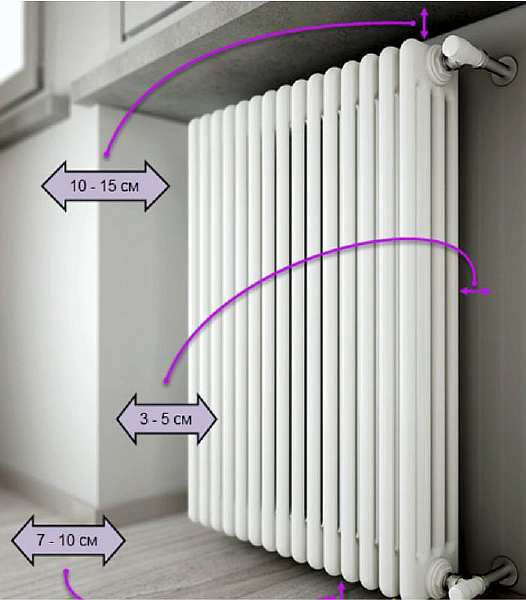

The purchased radiators must meet the GOST standards. Compliance is checked by reviewing the documents for the product in the store. Their absence may serve as a reason for refusing to purchase a product at this outlet.
Benefits of plastic window sills
Plastic structures have long supplanted wooden ones. They have such advantages as lightness, strength, water resistance, resistance to UV rays, therefore they retain their appearance for a long time. And most importantly, plastic window sills do not rot, and also have excellent thermal insulation properties.
It is worth noting their durability and ability to withstand temperature extremes (-30 - +60 degrees).
Window sills are easy to clean. You can wash them with detergents without being afraid to scratch. The range of colors is varied, ranging from white to decorative patterns, which are applied in production by the manufacturer.
Plastic window sill decorated with wood
The most popular are “wood-like” window sills and natural stone. They are also divided into matte or glossy. The latter are convenient to use, since dust does not clog up so much in their pores, and the varnish coating is able to protect against mechanical damage.
How to install a window sill under a plastic window - we start by choosing the main material
The construction market today offers a huge number of options for materials, manufacturing technologies and finishing of the outer layer. Both from a practical and aesthetic point of view, the best results are shown by products made of plastic (PVC, acrylic), natural and artificial stone. At the same time, plastic is much cheaper, lighter, easier to install and more practical. And in terms of aesthetic parameters, they are not inferior to stone products, since they are extremely diverse in appearance. - Manufacturers paint them in different colors, make them matte, glossy, laminate. Due to lamination, among other things, plastic window sills with colors and textures "like wood" or "like a stone" are obtained. This predetermines the choice of 90% of consumers and interior designers.
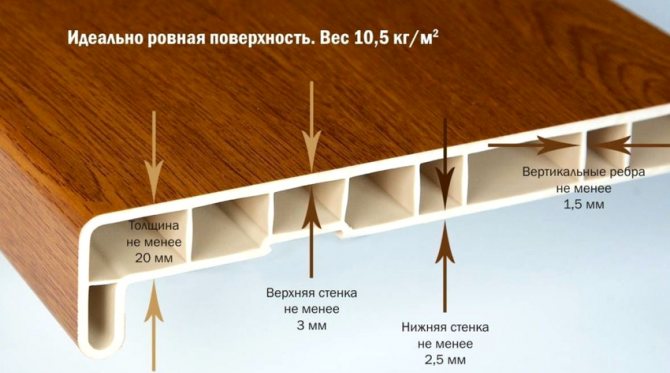

If we omit some details, then structurally we have two sheets of plastic connected by vertical ribs. The ribs provide the necessary rigidity, while the thickness of the product and elements should be no less than:
- The sill as a whole - 20 mm
- Top wall - 3 mm
- Bottom wall - 2.5 mm
- Stiffeners - 1.5 mm
If a manufacturer decides to save money and does not adhere to these requirements, look for another option, even if it does not look so impressive aesthetically.
From the point of view of resistance to mechanical, chemical and temperature influences, in ascending order of properties, plastic window sills are ranked as follows:
- Pvc
- CPL coated
- EPL coated
- acrylic
On acrylic, you can grind sand, extinguish a cigarette - there will be no traces.
In any case, you need to buy a slab of the required length and end caps of the corresponding color. For corner or very wide windows, you will also need connectors to fit the window sill parts together. A more complex option is not considered in the article, let's just say that in this case, you can cope with the work yourself.
How to determine the required size of the window sill
The long service life and quality of the window depends on the correct calculation and installation of this structure.
Initially, the workpiece should be cut to the desired length and width.
Probably, many wondered how wide the window sill should be? It is measured simply.
Measure the width of the window opening and add 6-10 cm (so that on each side the window sill protrudes at least 3 cm beyond the slopes). Since it is unacceptable that the plastic corners and the F profile protrude beyond it. For example, for a meter-wide window, a 110 cm window sill is needed, of which 2 cm will be spent on the light turn of the slopes and 8 cm for the allowances on the sides.
The window sill in the balcony block cuts into the wall on one side, and at the door it should protrude 1 cm.
This is how we calculated the length.
Calculating the width is no more complicated. To prevent the glass from fogging up, the window sill is brought 2 cm under the window, and it should protrude by 5-7 cm.This is due to the fact that the larger protrusion will block the access of heat from the battery, preventing the circulation of warm air, and its strength will also decrease. As a result, condensation will collect on the window, which will cause freezing. You should also measure the depth of the opening with a tape measure.Thus, it is necessary to add all 3 values, the sum of which will become the width.
Having received the necessary calculations, we cut out the plastic window sill. It is better to do this with a grinder or a jigsaw. It is impossible to press the jigsaw to PVC, as traces will remain. A regular saw can also be used, only the edges will not be perfectly straight. This is not very scary, the notches will hide the plastic overlays worn on the end of the product.
It is more difficult to measure for non-standard structures, for example, in rounded walls, kitchen countertops.
You can find detailed instructions for installing and installing a plastic window sill at the link. We also recommend reading an article on how to insert plastic windows yourself, while it is preferable to take into account the rules for installing windows in accordance with GOST.
In this case, it is necessary to make the width of the window sill uneven. A standard set of tape measure and a sheet of paper will not allow you to make an accurate template. The specialists of the company where you will place the order will help with this, and it is better to make a measurement with a tacheometer - more accurate geodetic equipment.
The product is almost ready. It remains to fit it under the opening. To do this, cut off the excess parts.
Please note that the windowsill on the sides should be recessed into the wall.
Make small indentations in the wall with a puncher, attach the workpiece to the opening and mark the cutouts taking into account the indentation. Now cut out the window sill and paste it into place.
Window sill installation scheme
When you install it, putty the holes you have made. You will get a monolithic window sill with a wall.
Plate installation and foam blowing
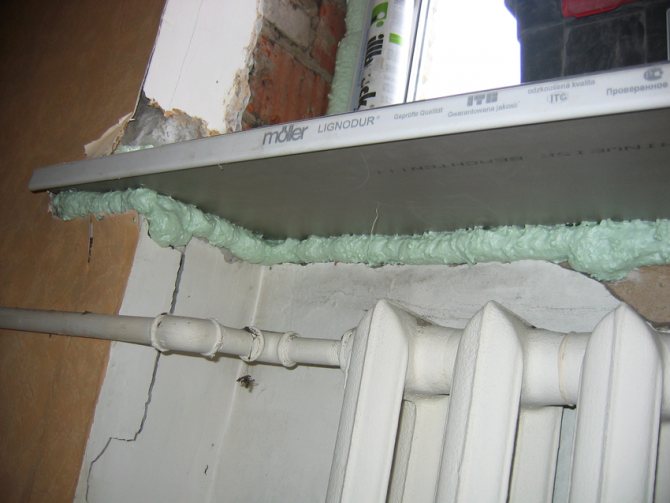

After application, the polyurethane foam expands and can raise (warp) the window sill. To avoid this, loads are used - water bottles, stacks of books or building materials. They need to be prepared in advance. Further, the procedure is as follows:
- We moisten the surface of the window sill building structure and the lower part of the window sill
- Reinstall the cut-out slab
- With a level, a corner, we once again check the correctness of installation, the strength of the support (it is important not to move the supporting elements during installation)
- We fill the window sill with foam
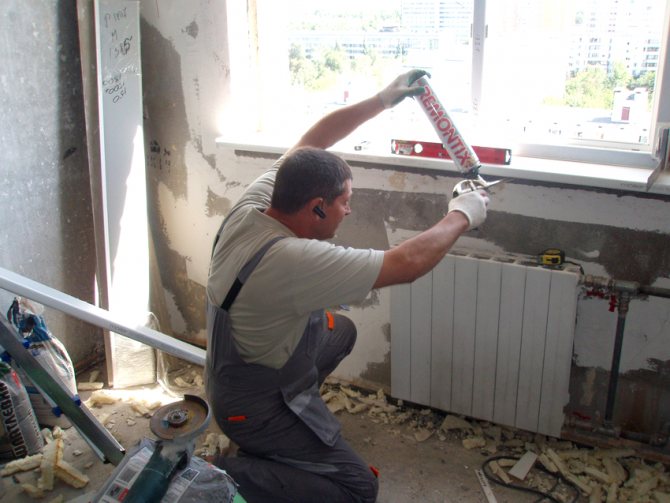

Again, if you watch a video on the topic "How to install a window sill on plastic windows" with advice from the masters of construction companies, this process will seem complicated. Experts will tell you that even for narrow window sills (30-40 cm wide), foam should be applied in two stages, and for wider ones - in three stages. That is, fill a third of the space closest to the window, in a day - the middle, and only then fill the last fragment farthest from the window with foam. In practice, these rules are usually not followed, and there is no appreciable deterioration in quality.
Other tips: You don't have to use the most expensive foam. Medium-priced options can also achieve a good result. Do not apply excess volume, especially in the part of the space closest to the room - not only the layer protruding beyond the wall, but also 1.5 cm deep will have to be removed during subsequent finishing.
- Not later than 5 minutes after applying the foam, we install the weights on the windowsill
- We pause for 2-3 days, necessary for complete polymerization and drying of the foam.
After that, all that remains is to cut off the excess frozen foam, finish finishing the walls, slopes, install and glue the plugs. The last operation is usually carried out at the time of completion of the repair.


Now you can install window sills on plastic windows yourself? If any part of the process still raises questions - watch the video and photos, contact our masters for advice.
Standard width and length of plastic window sill
These designs are produced with a standard blade, and already at the installation site are cut to the required size. Owners of old houses with non-standard sizes of products can purchase the required length and profile width on order.
What are the sizes of window sills for plastic windows?
The length of standard window sills starts at 4 and ends at 6 m. The width of the plastic window sill is from 10 cm to 1 m, step 5 cm. The most popular width is 11-60 cm, depending on the depth of the opening. The thickness varies from 1.8 to 2.2 cm, but usually it is 2 cm. Visually, the width of the PVC window sill increases due to the 4 cm of the edge of the kapinos.
Connection diagrams
Several schemes for connecting radiators into a single thermal system have been developed and are used. They are represented by the following types:
- the maximum heat output occurs with lateral connection, which involves mounting the input in the upper sector of the battery, the output is at the bottom on the same side;
- with a significant size of the heat sink, a diagonal connection is considered the best option, where water enters through the upper branch pipe, and is removed from the lower one, from the opposite side;
- when installing hot water supply pipes hidden under the floor surface, a circuit with a bottom connection, popularly called "Leningradka", is used.
Dimensions of a wooden window sill
A wooden window sill gives solidity, individuality and unusualness to the interior in a classic style, as well as a loft, Provence, hi-tech. It cannot be replaced in old houses either.
Wood has many benefits. Coated with water-repellent compounds, it can be installed in very humid rooms. It has aesthetic and functional benefits. Oak window sills are durable, do not crack and retain their presentable appearance for a long time, unlike plastic products. In addition, wooden structures can be restored.
They are veneered and spliced in length. Their thickness is 4 cm.
In veneered or all-lamellar window sills made of wood, thin plates - lamellas are glued along the length. Outside, the products are veneered with very thin wood overlays so that the wood does not curl during operation. The surface can be tinted and varnished.
Window sill width on the balcony
The choice of material for the window sill on the balcony is large enough. It can be wood, as the most affordable material, PVC and MDF, as well as concrete and natural stone. It all depends on the preferences and purpose of the balcony.
It is believed that wood is the least suitable for a balcony, but concrete and natural or artificial stone are difficult to work with and, moreover, they have a high cost. In this regard, modern materials win - plastic and chipboard, which have an impact-resistant and heat-resistant coating. And the size of the plastic window sills can be matched to any window.
Basically, small structures are installed on the balcony, with an average width of 20 cm, and the maximum width of the window sill is 60 cm. This is enough to make a winter garden, decorate the room with flowers, placing them on the window. And so that the structure is reliable, it is additionally reinforced with special corners.
Source: vse-postroim-sami.ru
- Call on Skype inchin64
Viber, WhatsApp: + 7-906-397-0062
window sill overhang above the radiator - the optimal value?
I looked on the website and forum for the answer to my question - should the window sill overlap the radiator and how much? Not found
